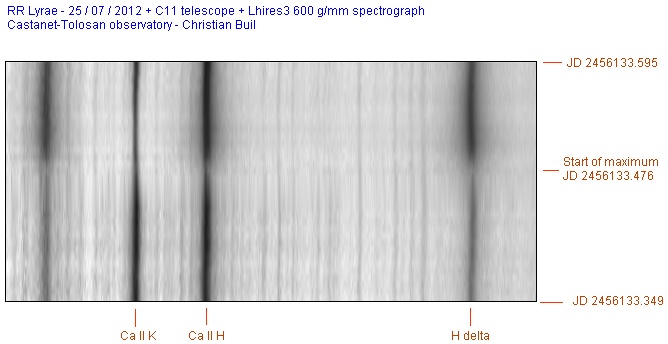|
Observation campain
of RR Lyr (spectroscopy + photometry)
RA
= 19 25 27.913, DEC = +42 47 03.69
(2000.0)
Call for observation from Jean-François
Leborgne (IRAP, Observatoire Midi-Pyrénées, 14 Avenue Edouard Belin,
F- TOULOUSE).
About this star and the campaign,
Jean-François says:
Pulsations of RR Lyr stars (evolution status: horizontal branch; period ~0.5
days; V amplitude ~ 1 mag.) are still not well understood. Thought
pulsating on similar modes as cepheids, they have smaller mass
(~0.8Mo) and different internal structure: secondary phenomena not seen
in cepheids are observed, such as period variations on years
time scale and particularly the modulation of period and
amplitude (Blazhko effect) on time scales of days to months. Blazhko
effect is not observed on every RR Lyr stars and some, as RR Lyr itself, show variations of the Blazhko effect on years time scale. None
of these phenomena has been satisfactorily explained by theory up to
now. It is then important to characterize them by observations.
One of the reason why such observations have not been intensively done
yet is that they are very time consuming: a time resolution of minutes
are necessary to study time scales from hours to years. It is
then clear what contribution amateurs (equipped with modest size
telescopes, CCD camera and possibly spectrograph) can bring to this research thanks to their availability and number.
An
intensive photometric campaign on the prototype star RR Lyr (mag. 7 to 8) is
in progress since 4 years. It has shown a spectacular dimming of
its Blazhko effect between 2008 and 2012.Though this phenomena
is known since the 1960's no such intensive campaign has been
done yet.
In 2012, we reach a new step by
including spectroscopic
observations by amateurs. The aim is to study dynamical variations of chocs in stellar atmosphere and variations of stellar parameters
(effective temperature, ...) as a function Blazhko effect
status. RR Lyr is the only star on which such a research can be
done because the other ones are much fainter having their
magnitude at maximum at 9 at best. Two kinds of spectroscopic
observations are implied in this research: low resolution spectrophotometry between 3500 and 7000A allowing the follow up hydrogen
and metallic lines (especially CaII K line), observations at
high resolution of Halpha line and some metallic lines which
allow the follow up of the deformation of the line due to shock
waves passing the atmosphere of the star during pulsation.
Ephemeris of RR Lyr maximum prediction:
http://rr-lyr.ast.obs-mip.fr/dokuwiki/doku.php?id=rrlyr2012
Contact: jean-francois.leborgne_at_irap.omp.eu
Campagne d'observation
de RR Lyr (spectrographie + photométrie)
AD = 19 25 27.913,
DEC = +42 47 03.69 (2000.0)
Les pulsations des étoiles de type RR Lyr (stade évolutif : branche horizontale;
période ~0.5 jour; amplitude en V ~ 1 mag.) sont encore
assez mal connues. Quoique pulsant sur des modes semblables à ceux des
céphéides, elles ont des masses bien moindre (~0.8Mo) et une
structure interne différente : des phénomènes secondaires absents de la
pulsation de céphéides sont observés. Il s'agit par exemple de
la variation de la période à l'échelle de quelques années et
surtout de la modulation de la période et de l'amplitude (effet Blazhko) sur
des échelles de temps de quelques jours à quelques
mois. L'effet Blazhko n'est pas observé dans toutes les RR Lyr et
certaines, comme RR Lyr elle-même, montrent des variations de
cet effet sur des échelles de temps de quelques années. Aucun
de ces phénomènes n'a trouvé d'explication théorique convaincante pour le moment. Il est donc important de les caractériser
observationnellement. Une des raisons pour lesquelles de telles observations
n'ont pas encore été faites de façon intensive est la
grande exigence demandée : il s'agit de
caractériser des phénomènes sur des échelles de temps qui vont
de l'heure à quelques années. On voit bien que la contribution des astronomes amateurs (équipés de télescopes de taille modeste et d'une
caméra CCD et éventuellement d'un spectrographe) dans ce
domaine est essentielle grâce à leur disponibilité et leur
nombre.
Une campagne d'observation photométrique intensive du prototype
de ces étoiles, RR Lyr (mag. 7 à 8) est en cours depuis 4 ans.
Elle a permis de mettre en évidence l'atténuation spectaculaire de son
effet Blazhko entre 2008 et 2012. Quoique ce phénomène soit
connu depuis les années 1960, aucune campagne d'observation aussi
intense n'avait encore été effectuée.
En 2012, un nouveau pas
est franchi dans cette recherche en mettant à contribution des observations
spectroscopiques par des amateurs. Il s'agit d'étudier les
variations de la dynamique des chocs dans l'atmosphère et des
paramètres stellaires (température effective, ...) en fonction
de l'état de l'effet Blazhko. RR Lyr est la seule étoile sur
laquelle ces observation sont possible car les autres étoiles de
ce type sont beaucoup plus faibles, ayant leur maximum à la magnitude 9,
au mieux. Deux types d'observations spectroscopiques sont
impliquées dans cette recherche : des observations
spectrophotométriques à basse résolution (R = 700 à 1000 typiquement) entre 3500 et 7000A
permettant de suivre l'évolution des raies de l'hydrogène et de raies
métalliques (en particulier la raie K de CaII), des observations à haute
résolution (plus de R = 8000) de Halpha et de quelques raies métalique qui permettent de suivre les
déformations des raies dues au passage d'ondes de choc dans
l'atmosphère de l'étoile pendant la pulsation.
Ephemeride des la prédiction
des maximum de RR Lyr : http://rr-lyr.ast.obs-mip.fr/dokuwiki/doku.php?id=rrlyr2012
Contact: jean-francois.leborgne_at_irap.omp.eu
|




